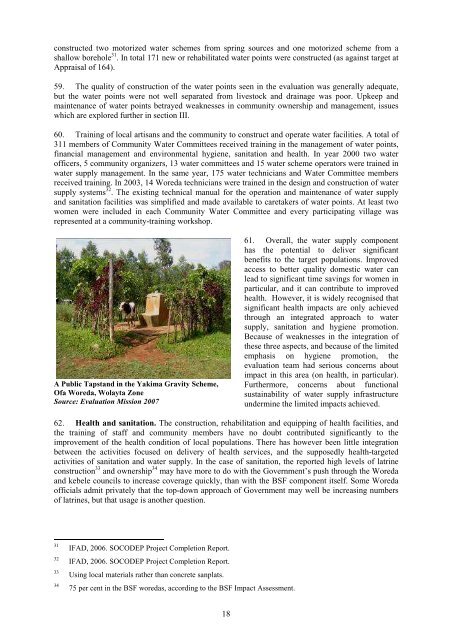Ethiopia SOCODEP CE - main report - IFAD
Ethiopia SOCODEP CE - main report - IFAD
Ethiopia SOCODEP CE - main report - IFAD
Create successful ePaper yourself
Turn your PDF publications into a flip-book with our unique Google optimized e-Paper software.
constructed two motorized water schemes from spring sources and one motorized scheme from a<br />
shallow borehole 31 . In total 171 new or rehabilitated water points were constructed (as against target at<br />
Appraisal of 164).<br />
59. The quality of construction of the water points seen in the evaluation was generally adequate,<br />
but the water points were not well separated from livestock and drainage was poor. Upkeep and<br />
<strong>main</strong>tenance of water points betrayed weaknesses in community ownership and management, issues<br />
which are explored further in section III.<br />
60. Training of local artisans and the community to construct and operate water facilities. A total of<br />
311 members of Community Water Committees received training in the management of water points,<br />
financial management and environmental hygiene, sanitation and health. In year 2000 two water<br />
officers, 5 community organizers, 13 water committees and 15 water scheme operators were trained in<br />
water supply management. In the same year, 175 water technicians and Water Committee members<br />
received training. In 2003, 14 Woreda technicians were trained in the design and construction of water<br />
supply systems 32 . The existing technical manual for the operation and <strong>main</strong>tenance of water supply<br />
and sanitation facilities was simplified and made available to caretakers of water points. At least two<br />
women were included in each Community Water Committee and every participating village was<br />
represented at a community-training workshop.<br />
A Public Tapstand in the Yakima Gravity Scheme,<br />
Ofa Woreda, Wolayta Zone<br />
Source: Evaluation Mission 2007<br />
18<br />
61. Overall, the water supply component<br />
has the potential to deliver significant<br />
benefits to the target populations. Improved<br />
access to better quality domestic water can<br />
lead to significant time savings for women in<br />
particular, and it can contribute to improved<br />
health. However, it is widely recognised that<br />
significant health impacts are only achieved<br />
through an integrated approach to water<br />
supply, sanitation and hygiene promotion.<br />
Because of weaknesses in the integration of<br />
these three aspects, and because of the limited<br />
emphasis on hygiene promotion, the<br />
evaluation team had serious concerns about<br />
impact in this area (on health, in particular).<br />
Furthermore, concerns about functional<br />
sustainability of water supply infrastructure<br />
undermine the limited impacts achieved.<br />
62. Health and sanitation. The construction, rehabilitation and equipping of health facilities, and<br />
the training of staff and community members have no doubt contributed significantly to the<br />
improvement of the health condition of local populations. There has however been little integration<br />
between the activities focused on delivery of health services, and the supposedly health-targeted<br />
activities of sanitation and water supply. In the case of sanitation, the <strong>report</strong>ed high levels of latrine<br />
construction 33 and ownership 34 may have more to do with the Government’s push through the Woreda<br />
and kebele councils to increase coverage quickly, than with the BSF component itself. Some Woreda<br />
officials admit privately that the top-down approach of Government may well be increasing numbers<br />
of latrines, but that usage is another question.<br />
31 <strong>IFAD</strong>, 2006. <strong>SOCODEP</strong> Project Completion Report.<br />
32 <strong>IFAD</strong>, 2006. <strong>SOCODEP</strong> Project Completion Report.<br />
33 Using local materials rather than concrete sanplats.<br />
34 75 per cent in the BSF woredas, according to the BSF Impact Assessment.

















